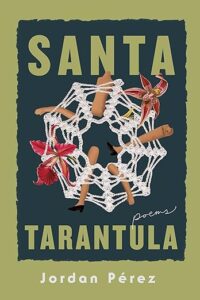Jordan Pérez writes of trafficking, prisons, Cuba, and abuse
I’ve seen some creative and arresting titles for poetry collections, but Santa Tarantula by Jordan Pérez may have just topped them all.
Santa Tarantula. Saint Tarantula.
My one personal experience with tarantulas (seeing one in movies like Home Alone doesn’t count) was in West Texas in 1975. I was in the parking lot of an oil pumping station, surrounded by miles of, well, West Texas. A tarantula about the size of my palm scurried less than a foot in front of me. I did what any self-respecting city slicker would do. I froze. And I stifled the yell in my throat.
Despite all the myths surrounding these large, hairy spiders, their venom is not deadly. It can cause allergic reactions, but the innate fear many people have is due to the idea itself of spiders (not to mention very large ones (and the one I encountered was very large)). When I see a poetry title like Santa Tarantula, I have to wonder what’s inside.
It is a collection with bite — not a fatal one, to be sure, but it does bite. The poems are jarring, jolting you out of your comfortable reading chair, say, or the quiet life you might be leading. They are written with passion and conviction. The poems are not polemical or political; they are closer to statements of reality, a reality that is difficult to grasp and understand, a reality that needs to be changed.
Pérez writes of subjects we’d prefer not to examine or at least not too closely. Subjects like child sexual abuse. Human trafficking. The imprisonment of people in Cuba. She also gives a voice to women in the Old Testament, like Tamar, Lot’s daughter, Delilah, Gomer, and Jael. No matter what she’s writing about, she will shove you out of complacency.
Read this poem by Pérez about childbirth, and ask yourself, who is actually giving birth here?
Upended

into strips and the yucca has been left
unboiled in the pot
and the tarantulas have lost
legs protecting their young.
The butterfly jasmine has been
itself at the very root to pay homage.
My mother’s dress has slipped over her shoulder
but we are birthing babies here?
Who cares about a shoulder?
There is also blood on her cheek
but I do not tell her that
because it makes her look strong
in the way that I, at twelve,
want to be strong; in the way that
might confuse birth and death,
in the way you find yourself upended
into the underwater reflection
and simply keep stomping
through the mud.

Jordan Pérez
Santa Tarantula is Pérez’s first poetry collection and was awarded the Andres Montoya Poetry Prize by the University of Notre Dame’s Institute for Latino Studies. She received an MFA degree from American University in 2019. Her poems have been published in several literary journals, including The Mississippi Review, Poetry, Poetry International, and others. She works as director of communications for SOSA, which is dedicated to the prevention of child sexual abuse. She has also received the Poetry International Prize and the Joy Harjo Prize, and she appeared in Season 2 of Undercover Underage, a docuseries on sex trafficking stings broadcast on several television channels.
The collection will be published Feb. 1, 2024.
What Pérez is saying in the poems of Santa Tarantula: don’t turn your face away. You know these things happen; you know children are being trafficked and women kidnapped into sexual slavery. Don’t pretend this isn’t your problem. If you’re part of humanity, it is your problem. And you’re going to have to ask what you should do about it.
Photo by Cloud Shepherd, Creative Commons, via Flickr. Post by Glynn Young.
How to Read a Poem uses images like the mouse, the hive, the switch (from the Billy Collins poem)—to guide readers into new ways of understanding poems. Anthology included.
“I require all our incoming poetry students—in the MFA I direct—to buy and read this book.”
—Jeanetta Calhoun Mish
- Poets and Poems: Sandra Marchetti and “Diorama” - April 24, 2025
- Poets and Poems: Christina Cook and “Roaming the Labyrinth” - April 22, 2025
- Longfellow’s “Paul Revere’s Ride”: Creating a National Legend - April 17, 2025


Laura Lynn Brown says
That’s a pretty arresting cover illustration, too! Thanks for introducing us to this one. I have seen one tarantula in the wild — on the edge of the main road running through Petit Jean State Park in central Arkansas. I got close enough to take some good pictures and was not scared. It seemed funny that they would use the blacktop road as well as the more protected grassy and forested areas, but of course they would.
I like the way this poem shows that tarantulas, too, will take risks and make sacrifices to fiercely protect their young.